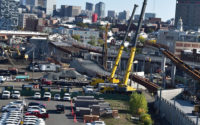The Metropolitan Transportation Authority's (MTA) East Side Access (ESA) project, the largest public transportation project nationwide, fell under heavy criticism yesterday for missing its budget by $4.4 billion and its completion date by 10 years. The result is that taxpayers must bear the brunt of the unanticipated costs of the project that is only half finished, according to a New York State Comptroller report released yesterday, March 6. The MTA had no comment on the report.
ESA's current cost estimate is $8.76 billion, including additional railcar costs, when completed in August 2019; it was initially expected to cost $4.3 billion and to begin service in 2009.
"Time and again, the MTA has come up short on the goal to deliver the East Side Access project on schedule and within budget," Thomas DiNapoli, state comptroller, said in a statement announcing the report. He said that the project, which will extend the Long Island Rail Road service to Grand Central Terminal, is an important addition to the mass transit system but that MTA must learn lessons from this experience as it moves forward with its capital program.
Debt service on MTA-issued bonds for the project is estimated to exceed $300 million in 2019, representing nearly 11% of the debt service for the agency's entire capital program that year, DiNapoli says. Debt service is reflected in the operating budget and funded with fares, tolls and tax revenue, he adds.
DiNapoli highlighted some of problems:
- Building the new LIRR terminal below Grand Central Terminal accounts for more than one-quarter of the cost overrun. The initial estimate for the terminal was $709 million, but is now $1.9 billion, up 170%.
- The Queens segment, which mostly involves tunneling, has doubled from $695 million to $1.4 billion.
- Track, signal and power and communication systems contract costs have nearly tripled, from $331 million to $901 million.
He said that the agency has acknowledged that its initial cost estimates and schedules that were submitted in 1999 were based on conceptual plans with "virtually no engineering work behind them." Reasons contributing to the cost hike and delay include overly aggressive schedules; the number of large concurrent infrastructure projects; a contractor that performed poor quality work; and unforeseen construction challenges, he says.
The agency estimates an 80% probability that the actual cost may be at or below its current estimate and that service could begin in 2018, DiNapoli says. "Conversely, there is a 20 percent probability of additional costs or delays," he adds.

